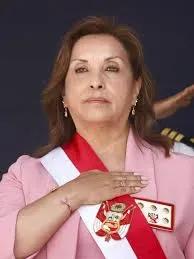Image of the ousted president of Peru, Dina Boluarte
On Friday, October 10, the Peruvian congress removed Dina Boluarte from the presidency of Peru for "permanent moral incapacity" to manage government tasks, triggering a profound crisis of insecurity and worsening the institutional crisis that Peru has been facing for several years.
In her place, José Jerí, a 38-year-old lawyer, took over as interim president, having sworn in as the president of the Republic from October 10 until July 2026, despite general elections taking place next April.
It is worth noting that Peru has had seven presidents in less than 10 years, counting those who have come to power since 2016, three removed from office, including former president Dina Boluarte, two who resigned before facing the same fate, and one who completed his interim term, now counted amongst Jerí. Among these presidents are Ollanta Humala (2011-2016), Pablo Kuczynski (2016-2018), Martín Vizcarra (2018-2020), Manuel Merino (2020), Francisco Sagasti (2020-2021), Pedro Castillo (2021-2022), Dina Boluarte (2022-2025), José Jerí (currently in office), alongside others like José Williams and Alejandro Soto who played a role within the congressional presidency during Boluarte's removal.
Until October 10, Dina Boluarte had no support or coalition in the Peruvian congress, much less popular support as she was cornered by scandals, protests, and a wave of extortion and murders committed by organized crime that had not been seen since before 1990, when the Shining Path guerrilla plagued Peru with acts of violence and terrorism until 1992 when it was defeated by the government of Alberto Fujimori (1990-2000). Following her removal, Boluarte stated that the congress had removed her from office with implications for the country's democracy, as she defined herself as a "democratic" person and a woman who came from deep moral values and worked to achieve the general welfare of Peru.
The causes of what is happening in Peru are multiple and have deep roots, dating back to 1992 with the self-coup by former president Alberto Fujimori, and this event represents a relevant historical moment that, while not directly related to current events, is part of an institutional, political, and social legacy that remains present in Peru today. What occurred in April 1992 is part of the DNA of the current Peruvian political system, due to the concentration of presidential power, a unicameral congress with little real control capacity, tolerance of authoritarianism, institutional weaknesses, and structural corruption, not to mention the lack of strong parties and a weak democratic culture that has allowed for a cycle of recurring political crises that, as of 2025, manifest as widespread distrust, institutional paralysis, and political violence.
In summary, what happened in 1992 is not the only cause but a continuity of events related to the current institutional weakness. The constitution currently in force was established in 1993 and had a political structure with strong presidentialism; however, with weak checks and balances, distrust towards the political class has emerged due to the increasing cases of corruption and clientelism, reflecting on the Peruvian congress with weak and personal alliances. The trauma of 1992 is revived with this new structural crisis, highlighted on October 10, where presidential vacancy has become a political instrument, and the presidency of Peru is seen as a burden for the politician occupying that position, making it a difficult task for anyone calling themselves the president of the republic.

Comments